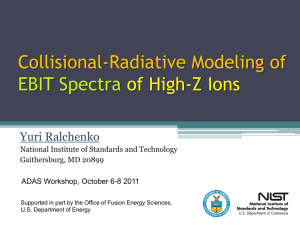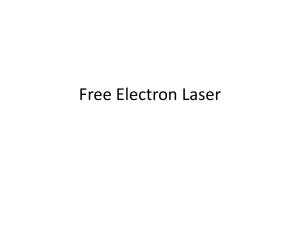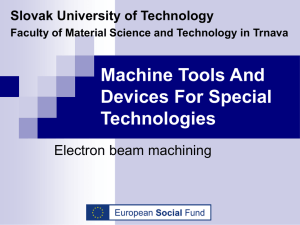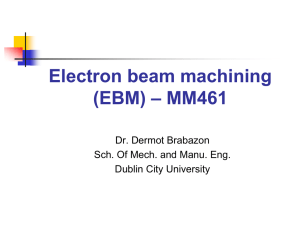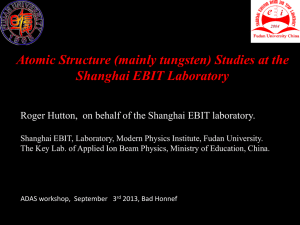Atomic Process in Spectroscopic modeling and their
advertisement
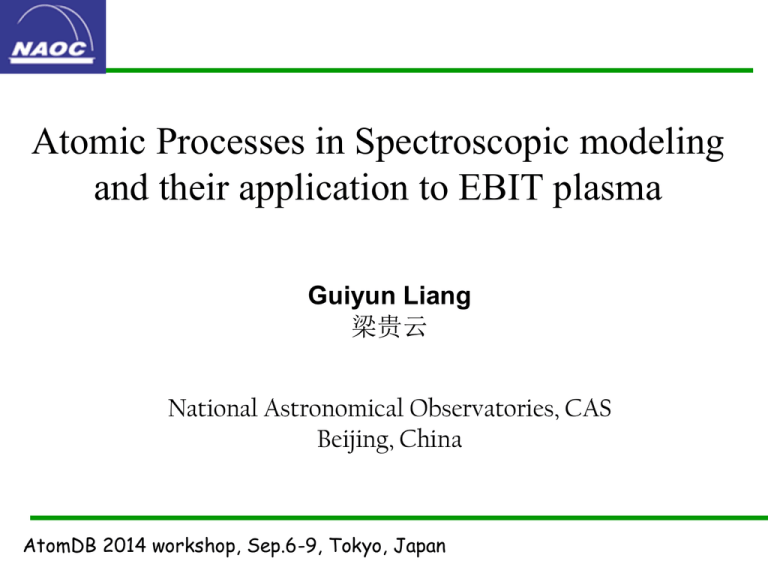
Atomic Processes in Spectroscopic modeling and their application to EBIT plasma Guiyun Liang 梁贵云 National Astronomical Observatories, CAS Beijing, China AtomDB 2014 workshop, Sep.6-9, Tokyo, Japan Collaborators UK APAP network Gang Zhao Jiayong Zhong Feilu Wang Huigang Wei Fang Li, Bo Han, Kai Zhang, Xiaoxin Pei Jose R. Crespo Lopeza-Urrutia Thomas Baumann Laboratory Astrophysics team Yong Wu Outline • • • • Background Atomic processes in modeling — SASAL EBIT and the EUV spectroscopy Applications to EBIT plasma (1) Density diagnostic (2) Overlap factor between the electron beam and ion cloud (3) Pressure diagnostic in EBIT center Background Our understanding to universe is from what we observed, e.g. Imaging, spectra, as well as imaging + spectroscopy. • The imaging at different photon energy give information from different regions. i.e. Optical: Photosphere UV: Chromosphere EUV+X-ray: Corona • SDO/AIA: 7 EUV channels (~2-10Å) O’ Dwyer et al. (2010) A&A, Dudik et al. (2014) ApJ New line identification from Fe IX around 94 filter, improves the response of the AIA/94 channel Dudik et al. (2014) ApJ, Foster & Testa (2011) ApJ • With aid of its high spatial resolution and high time cadence (<10s) of SDO, we can known: 1. temperature structure 2. plasma dynamics for a given region. However, a detailed dynamics (what velocity?) is still from spectroscopy with high spectral resolution, i.e. Hinode/EIS observation. EIS 284Å TRACE 171Å Milligan (2011) ApJ • Solar winds with planetary/cometary atmospheres Observation comet and vernus Lisse et al. (1996) Simulation of solar wind ions on Martian, Modolo et al. (2005) What components in solar wind? And/or what velocity of these ions? Spectroscopy Bodewits et al. (2006) The understanding to observed data depends on underlying models for emitters. Optical thin approximation ionization equilibrium • CHIANTI v7 (Solar, UK/USA) • AtomDB v2 (Stars/galaxy,etc, CfA) e - Collision • MEKAL • ADAS v2 (generalized CR, UK) for fusion plamsa • Cloudy • Xstar (various photoionized, NASA) Photoionization • MOCASSIN • SASAL (EBIT, coronal-like, etc, China) Recently, Chianti (v7.3) and AtomDB (v3.0) have been improved a lot by incorporating recent and more accurate atomic data. Landi et al. (2013); Foster et al. (2012) Fitting to obs. Example: SASAL model Output: emissivity Approx.coding Atomic data Physics: Liang et al. (2014) ApJ Atomic Processes in modeling (SASAL) • • • • • • • • Radiative decay (Aij) Excitation (EIE) Photo-excitation (PE) Collisional Ionization (CI) Photoionization (PI) Charge-exchange (CE) Radiative recombination (RR) Dielectronic recombination (DR) For different cases (e-collisional, photoionized, CXRec), different processes are included, a hybrid also can be done. • Structure and radiative decay Schrödinger/Dirac equation, many method: Cowan, CIV3, SuperStructure, FAC, HULLAC, Autostructure, Grasp, HartreeFock etc. H E N 2Z N 2 2 H (i ) ri i 1 j i rij Online data calculation by using FAC/AS based on predefined atomic model (configurations) H-like, He-like, Li-like, Belike, B-like, F-like, Ne-like, Na-like, Al-like sequences AUTOSTRUCTURE usage— S11+ (S XII) Function: RUN=‘’ • • • • • • Atomic structure (level energy、gf value) DE Electron excitation(DW) PI Non-resonant photoionization DR Dielectronic recombination RR Radiative recombination PE Photon excitation Badnell JPB, 1986, 19 827; CPC 2011, 182 1528 http://www.apap-network.org • Electron/Photon ion impact scattering 1. Distorted-wave UCL-DW, LADW, FAC, HULLAC, AS-DW (Badnell, 2011, CPC) 2. R-matrix Breit-Pauli, ICFT (intermediatecoupling frame transformation), DARC, CCC, B-spline Converged CC R-matrix: dividing space into internal and external regions (Breit-Pauli, ICFT, DARC) k ( x1 xN 1 ) ij ( x1 xN ; rN 1 N 1 )rN11u(rN 1 )aijk i i ( x1 xN 1 )bik J 1 ik jk Rij ( E ) RiB ( E ) ij a k Ek E r,E r a Automation of ICFT R-matrix calculation Developed by Whiteford, and implemented by Witthoeft, Liang and Ballance str das radial function inner dstg1 dstg3 dstg3 H.DAT nonx dstg1/2/3 dstgf dstgicf Perl adas8#lgy.pl rscript.inp dstgf dstgicf merge add outer born das limit value adas adasexj.in OMEGAU adf04 Analysis package: RAP, IDL routines tcc dstg1 dstg2 dstgjk TCCDW.DAT Results: Figures, tables EIE for iso-electronic sequence Data available at website http://www.apap-network.org • Method (ICFT) • Atomic model (large CI, computable CC) • Parallel calculation (Cluster-64 cores, HPC) Energy points: Partial wave: Consume time: Product: 200 000350 000 Jmax = 41, above Jmax, ‘top-up’ proceture 1-2 day 49 core/ion 1-3.5 GB/ion Under UK APAP-network, about 8 iso-electronic sequence data available now When the resonances included, the effective collision strength is NOT varied smoothly with nuclear number, so ‘interpolation’ is not valid to obtain those missed data Big Data • • • • • • Na-like sequence: Ne-like sequence: Li-like sequence: Si X: Fe XIV: S8+ — S11+ : 11.8Gb + 0.4 Gb 71.4Gb 88.7Gb + 2.7Gb 481 Mb 5.6 Gb +1.4 Gb (wo correct) 767 Mb (6.2 Gb) + 475Mb +7.6 Gb + 2.1 Gb Below only effective collision strength available • He-like: 4.8 Mb • F-like: 6.5 Mb • Collisional ionization Direct ionization, and excitation autoionization • Level resolved ionization data are calculated by using FAC for Helike, L-shell, Ne-like iso-electronic sequence ions from Li to Zn with pre-defined atomic model. • For some Si and Fe ions, a detailed check has been done with available experimental data. • Radiative recombination • Dielectronic recombination • Photoionization The data is from published papers, e.g. APAP, Witthoeft, Nahar’s calculation, Venner’s compilation etc. • Charge exchange Treatment of CX cross-section: Donors: • • • • • • • H (13.61) He (24.59) H2 (15.43) CO (14.10) CO2 (13.78) H20 (12.56) CH4 (12.6) • Default is parameterized Landau-Zener approximation • Collection from published data (RARE!) • Hydrogenic model 2s 2p 3d • Obtain the average energy of captured nl (3d) orbital • Using parameterized MCLZ approximation obtain the nlmanifold CX cross-section • Statistical weight to get the nlJ-resolved cross-section In Hydrogenic model: • Obtain the principle quantum number with peak fraction. 2s2 2p (ground) • ‘Landau-Zener’ weight as Si10+ projectile Smith et al. (2012) • Statistical weight How about this resultant CX cross-section? Not too bad! Solar Winds Rough data is better than no data available at all for astronomers. Test by soft x-ray spectroscopy from Comet 10 3 b) =1.4 Intensity (arb. unit) 10 10 Obs. Fitting 5+ C 6+ C 6+ N 7+ N 7+ O 8+ O 10+ Mg 14+ Ca 10+ Si FWHM=66 eV 2 1 0 10 200 300 400 500 600 700 800 Photon energy (eV) Because charge-exchange cross-section is a function of recipient velocity. We estimate a velocity of 600km/s, being consistent with that (592km/s) from direct sensor of ACE mission. A brief illustration of SASAL— Collision (EBIT) Original collision strength/cross-section was stored as post-database for various electron energy distribution, including R-matrix, DW data • Emission at non-equilibrium • Metastable effect • Non-equilibrium An approximate treatment relative to GCR model in ADAS We obtain the level population without contribution from ionization/recombination, this corresponds to the effective excitation to other metastable levels followed by ionization and/or recombination in GCR model. Very simple treatment at here with assumption of optical thin • electron excitation • photo-excitation • collision with neutral • The application to Z-pinch measurement reveals it is reliable. • Electron density will shorten the time-scale to equilibrium, e.g.at ne=1018 cm-3,it takes only a few ns. Obs. Theo. Si XIII 1.3 1.51 S XV 1.1 1.32 Ar XVII 0.8 0.97 Features of this model: • An extensive database composed of quantum calculation: Based on Chianti v7 and our recent calculations, including level energies, and radiative decay rates for HCIs • On-line calculations with ‘quantum’ method for some necessary parameter, including Levels, decay rates, excitation (DW), ionization, autoionization, CX cross-section: For CX, Multi-channel Landau-Zener with rotational coupling approximation is used, Hydrogenic model are also implemented into the present system. On-line CTMC calculation for CX cross-section is in plan. • Collection for published data with advanced treatment: Including R-matrix, Atomic-orbital and/or molecular-orbital close coupling, classical-trajectory Monte-carlo (CTMC) • Graphic interface for user operation and command line for extension with other hydrodynamics models Electron beam ion trap (EBIT) Electron beam ion trap has a powerful ability help us to benchmark the model: • Produce ions of a desired charge state 0.9 0.8 Fe XVII Fe XVIII Fe XIX Fe XX Fe XXI Fe XXII Fe XXIII Fe XXIV Ion fraction 0.7 0.6 0.5 0.4 0.3 0.2 0.1 0.0 10 100 1000 Temperature (eV) 1.0 Ion fraction 0.8 0.6 0.4 0.2 Fe XVII Fe XVIII Fe XIX Fe Fe Fe Fe Fe XX XXI XXII XXIII XXIV 0.0 500 1000 Epp et al. (2010) JpB; Beiersdorfer (2003) ARAA 1500 2000 Electron beam energy (eV) 2500 • Determine which lines come from which charge stage. • Study emission by selecting specific line formation processes Liang et al. (2009) ApJ; Martínez PhD thesis (2005) Some peoples in Laboratory astrophysics community try to benchmark theory on laboratory facility. 4.0 The long debating 3C/3D 3.5 3.0 3C/3D Nearly 40 years, the difference between the theory and observation is a hot topic. There are many explanation, such as 2.5 • Opacity; • Blending of inner-shell excitation of Fe XV ions • Recent measurement by LSLC laser and EBIT demonstrates that this is due to the high ratio of gf values in theory. Really? 2.0 1.5 800 Old theory (before 2000 year) Solar (Flare/AR and QS) Stellar Astrophysical observations 900 1000 1100 1200 Electron Energy (eV) Bernitt et al. (2012) Nature 1300 1400 EUV spectra measurement in EBIT • Heidelberg FLASH/Tesla EBIT • EUV spectrometer Grazing grating: 2400l/mm CCD 2048×2048, 13.5m/pixel • Beam energies: 100 — 3000 eV • Energy step: 10 or 20 eV • Photon energies: 90 — 260 Å • Photon resolution: ~0.3 Å • Pressure: ~ 10-8 mbar Epp PhD thesis (2007) In the global fitting, the profile of ‘evolution curve’ also affect by the relative line ratios of given ion. Our detail model analysis overcome this problem. EUV spectroscopic application to EBIT 1. Diagnostic to electron density in trap Line ratios involved emission lines with its upper level is dominantly populated from metastable levels 2. Overlap factor between e-beam and trapped ions Symbols with error bars are diagnostic results from He-like spectra at the same trap conditions. So this deviation is due to the different overlap factor? Chen et al. (2004) ApJ 3. Pressure diagnostic to trap center The central space is very small (55mmx10/3mm) to located a vacuum gauge, and that is separate from other space. What we measured pressure (108mbar) represents the value around the chamber wall. 𝑓(e,Xq+) refers to the overlap factor between the electron beam and ions with charge of q+, the last term represent a continuous injection of neutrals with density of n0+. Charge-exchange rates depends on the relative velocity (100 eV) of recipient (ions) and donor (neutrals). • The module of charge stage distribution Plasma type: Thermal EBIT EBIT/R with escape PhiBB CXERec For #Fe1008 measurement, there is total 50 beam energies. By an automatic fitting code, we obtain the observed count by a single run with predefined line-list. Ebeam = 1772 eV Iobs() = Ai(E)()(, E) Here, Ai(E) is the ionic abundance as a function of beam energy, () is the efficiency of the spectrometer, and (, E) is the line emissivity, where E refers to the beam energy There is two method to generate the ‘evolution curve’ Ai(E) • Global fitting • Single line fitting Line emissivity: ~ (E) or =AijNj relative spectrometer response 1 • For resonant lines, the uncertainty of (E) is within 5% • Cascading effect will have <10% contribution for line emissivity. 0.1 0.01 Hitachi grating efficiency CCD with SiO2 layer number of electrons generated per photon (normalised to 5 nm) relative factor (electrons/photon) 1E-3 5 10 15 20 Wavelength (nm) 25 30 Adopting global fitting, at each pixel channel and at a given energy, Evolution curve of ionic fraction Relative Ionic Fraction Fe XVIII Fe XIX Fe XX Fe XXI Fe XXII Fe XVIII Fe XIX Fe XX Fe XXI Fe XXII Fe XXIII 0.8 Fe1008 Fe1208 1.0 0.6 0.4 0.2 0.0 1200 1300 1400 1500 1600 1700 1800 1900 2000 2100 2200 2300 Electron Beam Energy (eV) Monte-Carlo method is adopted to obtain optimized neutral density with 300×300 tests • At low beam energies, the uncertainty (~10 eV) may be due to estimation of space charge potential, because only beam current at high energy recorded for #Fe1008 and #Fe1208 Fe XVIII Fe XIX Fe XX Fe XXI The resultant neutral density at the trap center without consider the overlap factor between electron beam and ion cloud At a current of 165 mA, and the beam energy 2390 eV, the largest central electron density is about 1.4×1013cm-3 An effective electron density is diagnosed to be 2.6×1012 cm-3 Fe XVIII Fe XIX The resultant pressure in trap center is obtained, that is still higher than expectation. In the central region, NO ‘quantitative’ value available, except for a ‘qualitative’ estimation. The present diagnostic strongly depends on the underlying model. A further analysis is on-going. Coulomb heating: Energy transfer between ions: Ion escape (radial, axial): Energy loss due to escaping ions: Vradial Vaxial Penetrante et al. (1991) Evolution of ions and ionic temperature: Penetrate et al. PRA (1991) Summary • Background • Atomic processes in theoretical modelling • Application to EBIT plasma a. Density diagnostic b. Diagnostic for overlap factor between beam and ions c. Diagnostic to the pressure in the EBIT center Thanks you for your attention!
